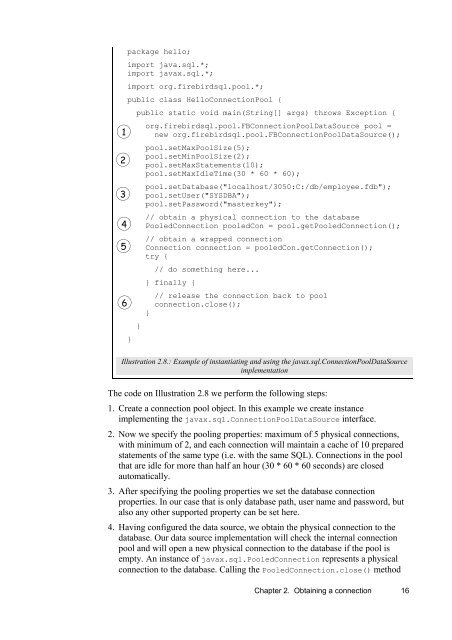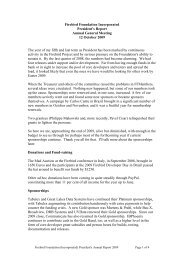Jaybird 2.1 JDBC driver Java Programmer's Manual - Firebird
Jaybird 2.1 JDBC driver Java Programmer's Manual - Firebird
Jaybird 2.1 JDBC driver Java Programmer's Manual - Firebird
You also want an ePaper? Increase the reach of your titles
YUMPU automatically turns print PDFs into web optimized ePapers that Google loves.
1<br />
2<br />
3<br />
4<br />
5<br />
6<br />
package hello;<br />
import java.sql.*;<br />
import javax.sql.*;<br />
import org.firebirdsql.pool.*;<br />
public class HelloConnectionPool {<br />
}<br />
public static void main(String[] args) throws Exception {<br />
}<br />
org.firebirdsql.pool.FBConnectionPoolDataSource pool =<br />
new org.firebirdsql.pool.FBConnectionPoolDataSource();<br />
pool.setMaxPoolSize(5);<br />
pool.setMinPoolSize(2);<br />
pool.setMaxStatements(10);<br />
pool.setMaxIdleTime(30 * 60 * 60);<br />
pool.setDatabase("localhost/3050:C:/db/employee.fdb");<br />
pool.setUser("SYSDBA");<br />
pool.setPassword("masterkey");<br />
// obtain a physical connection to the database<br />
PooledConnection pooledCon = pool.getPooledConnection();<br />
// obtain a wrapped connection<br />
Connection connection = pooledCon.getConnection();<br />
try {<br />
// do something here...<br />
} finally {<br />
}<br />
// release the connection back to pool<br />
connection.close();<br />
Illustration 2.8.: Example of instantiating and using the javax.sql.ConnectionPoolDataSource<br />
implementation<br />
The code on Illustration 2.8 we perform the following steps:<br />
1. Create a connection pool object. In this example we create instance<br />
implementing the javax.sql.ConnectionPoolDataSource interface.<br />
2. Now we specify the pooling properties: maximum of 5 physical connections,<br />
with minimum of 2, and each connection will maintain a cache of 10 prepared<br />
statements of the same type (i.e. with the same SQL). Connections in the pool<br />
that are idle for more than half an hour (30 * 60 * 60 seconds) are closed<br />
automatically.<br />
3. After specifying the pooling properties we set the database connection<br />
properties. In our case that is only database path, user name and password, but<br />
also any other supported property can be set here.<br />
4. Having configured the data source, we obtain the physical connection to the<br />
database. Our data source implementation will check the internal connection<br />
pool and will open a new physical connection to the database if the pool is<br />
empty. An instance of javax.sql.PooledConnection represents a physical<br />
connection to the database. Calling the PooledConnection.close() method<br />
Chapter 2. Obtaining a connection 16
















